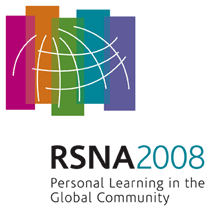
Abstract Archives of the RSNA, 2008
SSQ01-06
High Spatial Resolution Three-dimensional Spectroscopic Imaging in Breast Cancer in 12-15 Minutes as Part of a Multimodal Concept at 3 Tesla
Scientific Papers
Presented on December 4, 2008
Presented as part of SSQ01: ISP: Breast Imaging (MR Imaging Techniques)
Stephan Gruber MD, Presenter: Nothing to Disclose
Wolfgang Bogner MSC, Abstract Co-Author: Nothing to Disclose
Marek Chmelik MS, Abstract Co-Author: Nothing to Disclose
Katja Pinker MD, Abstract Co-Author: Nothing to Disclose
Andreas Stadlbauer MS, Abstract Co-Author: Nothing to Disclose
Siegfried Trattnig MD, Abstract Co-Author: Nothing to Disclose
In several studies it was shown that MR-spectroscopy (MRS) may be an important tool to detect malignant lesions due to increased choline (Cho) in tumor tissue. Most studies were performed using single voxel spectroscopy and two dimensional MR-spectroscopic imaging (2D-MRSI) in differentiation between benign and malignant lesion.
In this study, a high spatial resolution three dimensional MR-spectroscopic imaging (3D-MRSI) protocol at 3 Tesla was used in female patients to cover a large fraction of the breast in a clinically acceptable measurement time of approximately 12-15 minutes.
30 patients were successfully measured on a 3T system (Siemens Tim Trio, Erlangen, Germany) using a 4 channel breast coil. 3D-MRSI with PRESS preselection was used for all measurements (TR/TE = 750/145ms). The sequence included spectral water and fat suppression and spatial outer volume suppression. Voxel size was 1 cm x 1cm x 1cm in all measurements. The Field of View (FOV) was chosen to cover the whole breast. Acquisition weighting was performed using a hamming-filter (100%) and 4-10 averages per measurement. SNR of Choline (Cho) was estimated using LCModel. Additionally, metabolic maps of Cho (if detectable) were created using laboratory software.
In 7 of 30 patients increased Cho was detected in more than one slice with high SNR (≥ 5). Data quality was excellent over the whole PRESS box, even in short distance from the lung tissue.
In 6 of 7 patients cancer was confirmed via biopsy. (In one patient results from biopsy were not available). Up to 1000 voxels were quantified per patient. In patients with cancer Cho may be detectable in several slices and hundreds of voxels - allowing to calculate the distribution of Cho (i.e. malignant tissue) in the whole PRESS box.
In this pilot study we performed 3D-MRSI in patients with breast lesions with excellent data quality. In all patients with confirmed cancer, Cho was detectable in more than one slice, pointing out the importance of 3D-MRSI for diagnosis of breast cancer. We confirmed previous
results, reporting Cho in malignant breast tissue. However, we were able to cover a larger fraction of the breast.
3D-MRSI at 3 Tesla allows to cover a large fraction of the breast within 12-15 minutes with high specificity. Therefore, 3D-MRSI may improve diagnosis of breast cancer significantly.
Gruber, S,
Bogner, W,
Chmelik, M,
Pinker, K,
Stadlbauer, A,
Trattnig, S,
High Spatial Resolution Three-dimensional Spectroscopic Imaging in Breast Cancer in 12-15 Minutes as Part of a Multimodal Concept at 3 Tesla. Radiological Society of North America 2008 Scientific Assembly and Annual Meeting, February 18 - February 20, 2008 ,Chicago IL.
http://archive.rsna.org/2008/6015713.html

